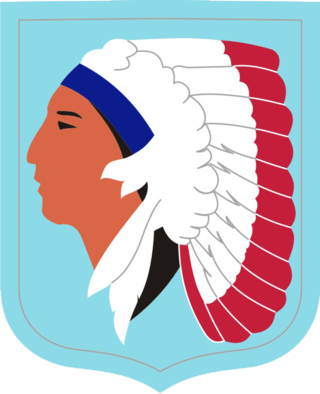The Australian honours and awards system refers to all orders, decorations, and medals, as instituted by letters patent from the Monarch of Australia and countersigned by the Australian prime minister at the time, that have been progressively introduced since 14 February 1975. The Australian honours and awards system excludes all state and local government, and private, issued awards and medals.

The Medalje vir Troue Diens - Medal for Loyal Service was instituted by the President of the Republic of South Africa on 16 April 2003 and came into effect on 27 April 2003. It can be awarded to all ranks whose character and conduct have been irreproachable and who have completed ten years of qualifying service.

The Oklahoma National Guard, a division of the Oklahoma Military Department, is the component of the United States National Guard in the U.S. state of Oklahoma. It comprises both Army (OKARNG) and Air (OKANG) National Guard components. The Governor of Oklahoma is Commander-in-Chief of the Oklahoma National Guard when not on federal active duty. The state's highest-ranking military commander, the Adjutant General of Oklahoma (TAG), serves as the military head of the Guard and is second only to the Governor. The TAG is served by Assistant Adjutants General, all brigadier generals, from the OKARNG and OKANG. The two components each have a senior noncommissioned officer, State Command Sergeant Major for Army and State Command Chief Master Sergeant for Air. The TAG is also served by his Director of the Joint Staff or Chief of Staff, who has direct oversight of the state's full-time National Guard military personnel and civilian employees.
The Governor-General of Australia has, at irregular intervals, notified for general information notifies the positioning of wearing of Australian orders, decorations and medals in the Commonwealth of Australia Gazette. The Order of Wearing Australian Honours and Awards was last published in 2007.

The Dekoratie voor Trouwe Dienst, post-nominal letters DTD, is a South African military decoration. It was instituted in 1920 as a retrospective award for Boer officers of the 1899–1902 Second Boer War.
The Australian Police Medal (APM) is awarded for distinguished service by a member of an Australian police force. The APM was introduced in 1986, and replaced the Imperial King’s Police Medal for Gallantry and King’s Police Medal for Distinguished Service.
The Australian Fire Service Medal (AFSM) is awarded for distinguished service by a member of an Australian fire service. The AFSM was introduced in 1988, and replaced the Imperial awards of the Queen's Fire Service Medal for Gallantry and the Queen's Fire Service Medal for Distinguished Service. Recipients of the Australian Fire Service Medal are entitled to use the post-nominal letters "AFSM".
The Ambulance Service Medal (ASM) is awarded for distinguished service by a member of an Australian ambulance service. The ASM was introduced in 1999.
The National Emergency Medal is an award of the Australian honours system given for sustained service during a nationally significant emergency; or to other persons who rendered significant service in response to such emergencies. The medal was established by Queen Elizabeth II in October 2011. The medal is awarded for events specifically set out by regulation or may be awarded upon the recommendation of the National Emergency Medal Committee for significant service.
The 2010 Australia Day Honours are appointments to various orders and honours to recognise and reward good works by Australian citizens. The list was announced on 26 January 2010 by the Governor General of Australia, Quentin Bryce.
The 2013 Australia Day Honours were announced on 26 January 2013 by the Governor-General of Australia, Quentin Bryce.
The Order of Wearing of Australian honours includes Imperial honours if they were awarded prior to 6 October 1992. Imperial honours awarded after 5 October 1992 are considered foreign.

The Army Long Service and Good Conduct Medal was instituted by King William IV in 1830. The medal remained in use for 100 years, until it was replaced by the Medal for Long Service and Good Conduct (Military) in 1930. During that time the reverse of the medal remained virtually unchanged, while the design of the obverse was altered during the reigns of Queen Victoria, King Edward VII and King George V.
The 2016 Queen's Birthday Honours for Australia were announced on 13 June 2016 by the Governor-General, Sir Peter Cosgrove. The Birthday Honours were appointments by some of the 16 Commonwealth realms of Queen Elizabeth II to various orders and honours to reward and highlight good works by citizens of those countries. The Birthday Honours are awarded as part of the Queen's Official Birthday celebrations during the month of June.
The 2017 Australia Day Honours were announced on 26 January 2017 by the Governor General of Australia, Sir Peter Cosgrove.
The 2017 Queen's Birthday Honours for Australia were announced on 12 June 2017 by the Governor-General, Sir Peter Cosgrove.

The Australian Corrections Medal (ACM) is a civil decoration awarded to Australian correctional service members for distinguished service. The ACM was introduced on 19 June 2017. Recipients of the Australian Corrections Medal are entitled to use the post-nominal letters "ACM".
The 2009 Australia Day Honours are appointments to various orders and honours to recognise and reward good works by Australian citizens. The list was announced on 26 January 2009 by the Governor General of Australia, Quentin Bryce.
The 2008 Australia Day Honours are appointments to various orders and honours to recognise and reward good works by Australian citizens. The list was announced on 26 January 2008 by the Governor General of Australia, Michael Jeffrey
The Australian Intelligence Medal (AIM) is a civil decoration awarded to national intelligence community members for distinguished service. The decoration was introduced on 24 January 2020. Recipients of the Australian Intelligence Medal are entitled to use the post-nominal letters "AIM".





